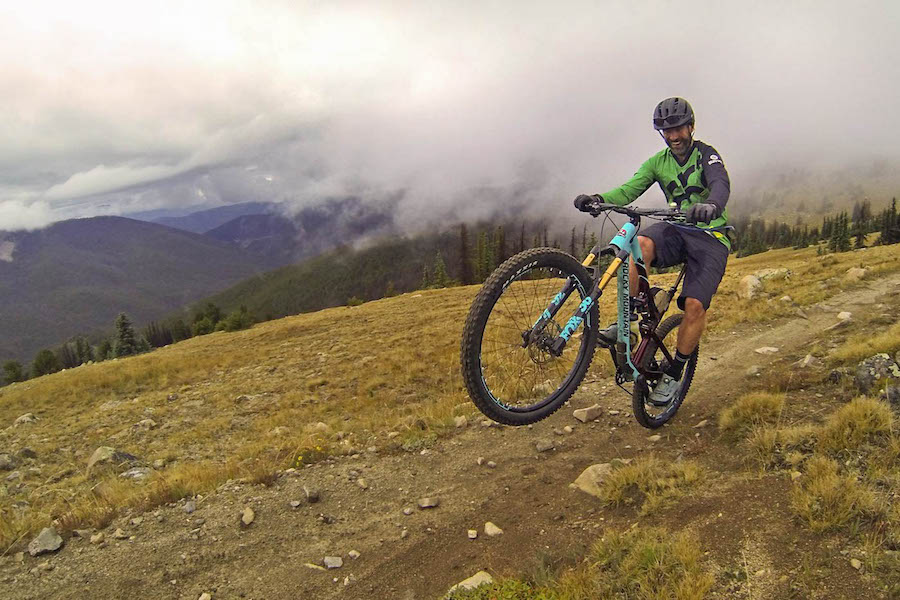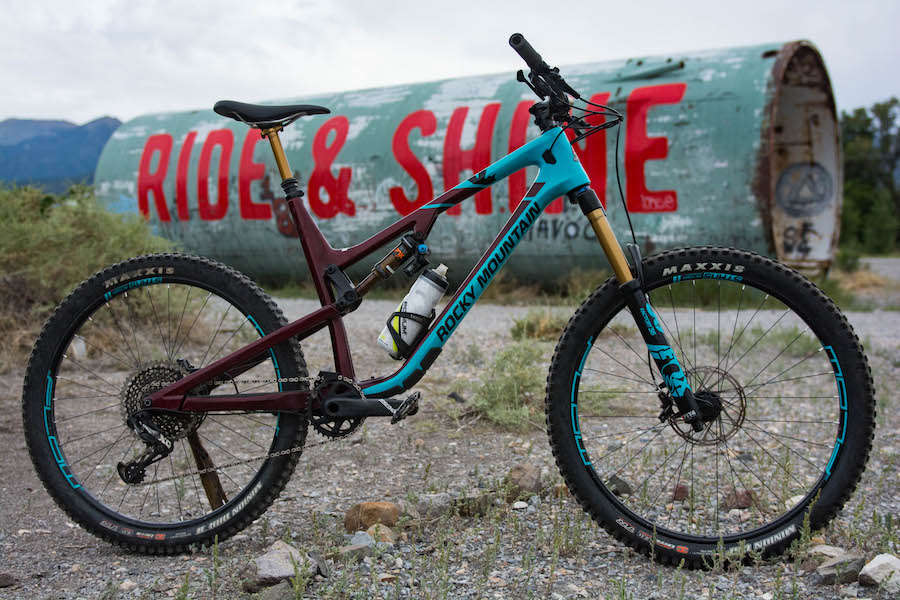Rocky Mountain Altitude Carbon 90
Originally posted on March 12, 2019 at 4:20 am2018 Rocky Mountain Altitude Carbon 90
Tester: Zach White
Age: 43
Weight: 205 lbs
Height: 6’ 3”
Inseam: 32”
Price: $7,399
Sizes: XS, S, M, L, XL(tested)
Online: bikes.com
Reach: 19.1”
Stack: 24.5”
Top Tube: 25.8”
Head Tube: 65.0°
Seat Tube: 74.1°
BB Height: 13.2”
Chainstays: 16.7”
Weight: 27.9 lbs.w/o pedals, specs based on size tested
Rocky Mountain’s all-new Altitude is a refreshing scenario where a company’s effort in completely revamping a model hits the mark quite well in their own camp, yet does so without pushing the boundaries of current industry trends. Specifically, while Rocky Mountain did make the Altitude quite a bit longer, lower and slacker by direct comparison to the previous generation – the head tube angle alone is a full two degrees slacker this year – the end result falls pleasantly onto the conservative side of the trail bike average these days. Whether or not it was in ignorant bliss of what the other brands were up to, Rocky Mountain made the Altitude low enough, long enough and slack enough to provide a welcome break in the trends of turning trail bike geometry into a rolling stretch rack.

In addition to a geometry update, the Altitude also sees a beefed up, stiffer chassis thanks in part to new Smoothwall carbon construction, 148 mm Boost spacing that also helps allow for 2.6-inch tires, and replacement of the old bushing pivots with sealed bearings all around. Internal routing keeps things visually clean and tidy, and after future-proofing its bikes for what seems like a few years now, there’s a perfect interface on the down tube for that fancy new Fox Live, as well as a spot for a Di2 battery. And, a perfect mix of form and function, blind pivots near the axle provide both an appreciated ankle clearance and a clean look, to boot.

The Altitude Carbon 90 weighs in at just under 28 pounds without pedals, which is a very respectable number on a 160/150 mm front/rear travel bike with alloy rims and Maxxis Minions. Rocky’s Spirit Guide gives the dedicated single-ring design a bit of insurance and is vertically adjustable in case the stock 34-tooth ring doesn’t offer the desired gearing. It should be noted that the Spirit Guide only has minimal lateral adjustability, so swapping the cranks or anything that alters the stock chainline means that there’s a solid chance the guide won’t be compatible. This was the case when swapping over to a set of Rotor cranks for a separate review. Integrated down tube and chainstay protection is well-executed, and a thoughtful clear plastic frame protector where a truck bed pad would land is appreciated.

The Altitude features Rocky’s Ride 9 geometry and rise-rate adjustment, which offers, you guessed it, nine different positions in a set of flip-chip style offset shock mounts that essentially slacken or steepen the geometry while simultaneously increasing or decreasing its rising rate in a range between 47.2 and 22.8 percent. In other words, the slacker geometry options create softer initial suspension rates that firm up more toward the end, and the steeper geometry options provide firmer initial stroke that’s a bit more linear through the end stroke. However, Rocky claims that their “moderately progressive” spring rate stays constant throughout all nine positions, which will either confuse or excite you. In the neutral position, head tube angle is 65.6 degrees, seat tube angle is 74.6 degrees, and bottom bracket drop is 7 mm.
The Ride
Setting up the Altitude’s suspension was a touch finicky and required bumping up shock pressure to equate to approximately 25 percent sag to stay out of the midstroke of the “moderately progressive” spring rate. The design itself takes more air pressure than some designs – in my case, air pressure equated to body weight plus 80 psi, which almost maxed out my shock pump. Rebound damping was set a little slower than usual in an effort to help improve pedal efficiency. Rocky Mountain’s Size Specific Tune equates to shocks on sizes XS-M having one size smaller air volume spacer than the large and XL, so there’s a good chance that my 205 pound weight on the XL could have benefited from bumping up the spacer another notch, thereby making it easier to stay out of the midstroke while maintaining a more normal 30 percent sag setting for a bike of this genre.

Once the suspension was set up as best as could be, the Altitude really changed its attitude out on the trail. Though it’s by no means short, it felt noticeably easier to sneak through tough rock gardens and tight, steep switchbacks that generally heckle modern bikes with long wheelbases. Outside of rough, tricky trail sections, the Altitude was also refreshingly easy to ride at more mellow speeds. So many trail bikes these days tend to demand an aggressive, forward-leaning position just to keep them under control on breezeways, but the Altitude let me back off the speed and enjoy the scenery when there wasn’t enough gas in the tank to attack every part of the trail. I even took it for an overnight bikepacking trip on part of the Colorado Trail and never second-guessed the decision. On the flip side, racing it at the Vail Outlier Enduro a few weeks later highlighted just how capable the Altitude is when faced with lift-accessed run after run of abuse. The wheels were another story, but the chassis left all excuses for not going faster on my end.

The Altitude’s rather lightweight chassis never hinted that it came at a tradeoff of frame stiffness, as it behaved quite predictably and consistently throughout the test period. This, in conjunction with its geometry, ultimately made the Altitude a pleasure to ride and built more trust with each day it was ridden. Pedal efficiency left a bit to be desired by current standards, and the Fox Float DPX2 was rarely in its open mode when not committed to long, rough descents. It isn’t bad in the pedaling department – but for how well so many bikes in this category propel these days, it’s just a touch subpar compared to what’s currently among the best.

The build kit was mostly great, although the Stan’s wheels didn’t hold up well at all. A spoke on the rear wheel randomly snapped on a mellow trail day, and in general, both wheels needed to be trued on several occasions within a couple of months, which isn’t a normal occurrence for me. Otherwise, the Fox Factory suspension performed well, as did the Fox Transfer dropper. Sram’s drivetrain held up well, though the 34-tooth ring was a touch tall on a few occasions.

Overall, the new Altitude is a fun bike that fits right in as a competitive choice in the sea of 150 mm travel trail bikes being offered these days. It’s not the best pedaler out there by any means, but the lighter-than-average weight, dialed geometry and potential for a custom shock tune could negate this hiccup for many. Could there be a better pedal platform hidden in the Ride 9 adjustability? Maybe slightly, but when I contacted Rocky Mountain about improving the pedal platform and keeping it out of the midstroke, nothing about Ride 9 was mentioned, much less suggested. The trail manners were impressive, and its flexibility of being perfectly suited for all-day rides in the Colorado high country one day, enduro racing the next day, and even a bit of multi-day adventuring makes for a solid argument in favor of the Altitude being a great choice for riders in search of a bike that won’t pigeonhole their rides.